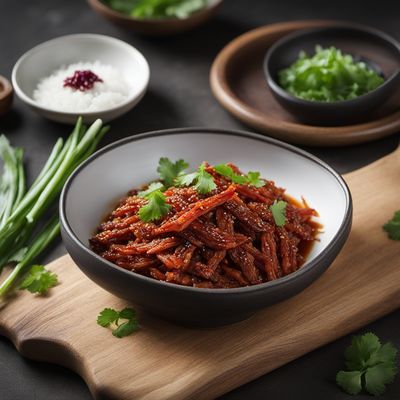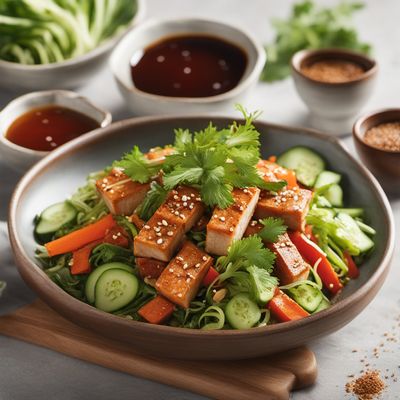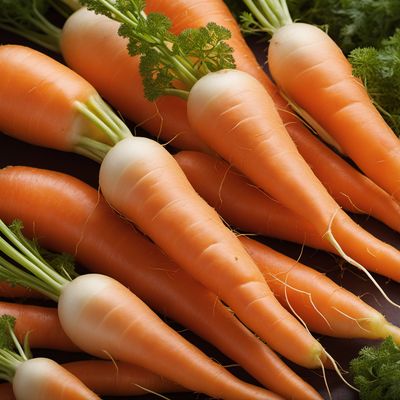
Ingredient
Carrots and similar-
The Vibrant Roots: Carrots and Their Kin
Carrots and similar root vegetables, such as parsnips and turnips, are known for their vibrant colors, ranging from deep orange to pale yellow and creamy white. They have a firm texture and a sweet, earthy flavor that becomes even more pronounced when cooked. These versatile vegetables can be enjoyed raw, roasted, steamed, or used in soups, stews, and stir-fries.
Origins and history
Carrots are believed to have originated in Central Asia thousands of years ago and were initially cultivated for their aromatic leaves and seeds rather than their roots. They were later domesticated and spread to different parts of the world, becoming an essential ingredient in various cuisines. Carrots have a rich historical significance, being mentioned in ancient texts and depicted in artwork from different civilizations.
Nutritional information
Carrots and similar root vegetables are low in calories and packed with essential nutrients like vitamin A, vitamin K, and dietary fiber. They also contain antioxidants that promote eye health and boost the immune system.
Allergens
Carrots and similar root vegetables are generally safe to consume, but some individuals may be allergic to them, experiencing symptoms like itching, swelling, or difficulty breathing. If you have known allergies to carrots or related vegetables, it is best to avoid them.
How to select
When selecting carrots and similar root vegetables, look for firm, smooth, and brightly colored specimens. Avoid carrots that are soft, wilted, or have cracks or blemishes. The greens attached to the carrots should be fresh and vibrant, indicating their freshness. For parsnips and turnips, choose ones that are firm and free from soft spots or signs of decay.
Storage recommendations
To maintain the freshness of carrots and similar root vegetables, remove the greens before storing them in a plastic bag or a perforated plastic bag in the refrigerator. They can last for several weeks when stored properly. Parsnips and turnips should be stored in a cool, dark place, such as a root cellar or the vegetable drawer of the refrigerator, and used within a week or two.
How to produce
Carrots and similar root vegetables can be grown in home gardens or containers. They require well-drained soil, regular watering, and full sun exposure. Sow the seeds directly in the ground or start them indoors and transplant them once they have developed a few leaves. Harvest the roots when they have reached the desired size, usually after 60-80 days.
Preparation tips
Carrots and similar root vegetables can be enjoyed in various ways. They can be eaten raw as a crunchy snack, grated into salads, or used as a base for soups and stews. Roasting brings out their natural sweetness, while steaming preserves their vibrant color and nutrients. They can also be pickled, pureed, or used in baked goods like carrot cake or parsnip muffins.
Substitutions
Parsnips can be used as a substitute for carrots in most recipes, although they have a slightly sweeter and nuttier flavor. Turnips can be used as a substitute for carrots in savory dishes, but they have a more peppery and slightly bitter taste. If you're looking for a non-root vegetable substitute, bell peppers can provide a similar crunch and vibrant color to dishes.
Culinary uses
Carrots and similar root vegetables are widely used in various cuisines around the world. They are commonly used in soups, stews, and stir-fries, adding flavor, texture, and color to the dishes. Carrots are a staple in dishes like carrot cake, coleslaw, and glazed carrots. Parsnips are often roasted or pureed into creamy soups, while turnips are used in stews, gratins, and pickles.
Availability
Carrots and similar root vegetables are commonly available in grocery stores, supermarkets, and farmers markets worldwide. They are cultivated in many countries, including the United States, China, Russia, India, and France.
More ingredients from this category
Recipes using Carrots and similar- » Browse all

Canadian Chinese Style Sweet Dumplings
Maple-infused Sweet Dumplings with a Chinese Twist

Chinese-style Niçoise Salad
East Meets West: A Fusion of Flavors in Chinese-style Niçoise Salad

Donkey Burger with Spicy Hoisin Sauce
Fiery Donkey Delight: A Spicy Twist on Chinese Donkey Burger

Refreshing Summer Noodle Salad
Chilled Delight: A Vibrant Twist on Japanese Hiyashi Chūka

Baekseolgi - A Note by Note Twist
The Art of Baekseolgi: A Note by Note Culinary Masterpiece

Korean-style Crispy Kohli Bourbouristi
Kohli Bourbouristi: A Korean Twist on Greek Crispy Delight

Mongolian-Style Beef Noodle Soup
Savory Mongolian Beef Noodle Delight

Spicy Korean Tofu Salad
Fiery Tofu Delight: A Spicy Korean Salad

Chinese Indonesian Pulled Pork Nachos
Crispy Pork Nachos with a Chinese Indonesian Twist

Luganega-inspired Kimchi Sausage Stew
Savory Kimchi Sausage Stew with a Lombardian Twist

Dorset-style Grilled Pork Rice (Cơm tấm sườn)
Dorset Delight: Grilled Pork Rice with a Twist

Nikujaga - Japanese Beef and Potato Stew
Umami Delight: Japanese Beef and Potato Stew

